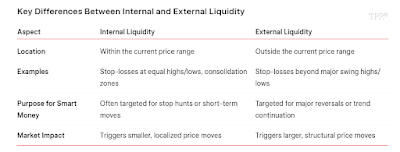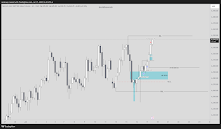There are six Intraday Templates and Trading Setups for the S&P (ES), the Nasdaq (NQ) and the Dow Jones (YM) - three bullish and three bearish ones:
- Two Session Up Close OR Two Session Down Close. (1.1 + 1.2)
- AM Rally and PM Reversal OR AM Decline and PM Reversal. (2.1 + 2.2)
- Consolidation AM Rally and PM Decline OR Consolidation AM Decline and PM Rally. (3.1 + 3.2)
1.1 Two Session Up Close (Trend Day ≈ 10% of all trading days) If we are in the middle of an intermediate or long term price swing based on what we would see on the HTF (Higher timeframes = 4 hour, daily, weekly, monthly) chart, this is the classic scenario. When we start approaching HTF opposing arrays, this profile is less likely to occur. The daily range can go straight trough the lunch hour with very little consolidation whatsoever, depending on what the catalyst was that send prices higher it could be a very strong economic news release. Don't think we’ll always get the consolidation in lunch hour, if we move higher fast there is a chance they work trough lunch. PM session would be ideal if its symmetrical to the AM session.
- Institutional Order Flow (IOF): Bullish.
- AM Trend: Returns to a Discount Array then rallies.
- Lunch Hour: Consolidates with shallow retracements.
- PM Trend: Runs the Lunch Hour Lows [Sell Stops] OR Drops into a Fair Value (FV) Discount Array then rallies into Close.
1.2 Two Session Down Close (Trend Day ≈ 10% of all trading days) If we are in the middle of an intermediate or long term price swing based on what we would see on the HTF chart, this is the classic scenario. When we start approaching HTF opposing arrays, this profile is less likely to occur.
- Institutional Order Flow: Bearish.
- AM Trend: Returns to a Discount Array then declines.
- Lunch Hour: Consolidates with shallow retracements.
- PM Trend: Runs the Lunch Hour Highs [Buy Stops] OR Rises into a Fair Value Discount Array then declines into Close.
Tips for Two Session Up Close OR Two Session Down Close = trending days:
► When daily and 4H institutional order flow is bullish (two session up close)/bearish (two session down close).
► If we're in the middle of an intermediate term or long term price swing based on what we see on the HTF chart, then this is the classic scenario until we start approaching an opposing array on the 4h/daily/weekly. PM session would be ideal if its symmetrical to the AM session (measured move).
► The daily range can go straight through the lunch hour with very little consolidation whatsoever, depending on what the catalyst was that send prices higher it could be a very strong or surprised economic news release.
► Don't think we'll always get the consolidation in lunch hour, if we move higher fast there's a chance they work through lunch.
► ► How to trade: ICT always looks for SMT (Smart Money Tool / Smart Money Technique) between the 3 indices at the lows/highs on both sessions.
AM SMT: compare London lows/highs and 9:30 am lows/highs.
PM SMT: compare lunch lows/highs and the high/low formed from the 13:00 candle. One has to diverge.
AM session hold till about 10:30-11:00 and also look for 15m PD arrays.
PM session: besides the SMT we can also return to FVG or OB formed in lunch hour.
2.1 AM Rally PM Reversal (Typical Day ≈ 25% of all trading days) Price is yet to fulfill a completion of a bullish run, but very close to where we are presently there is a higher time frame premium PD (Premium/Discount) array. The session will start off bullish until it hits the HTF PD array which causes the intraday market reversal.
- Institutional Order Flow: Bullish - under HTF Premium-Discount Array.
- AM Trend: Returns to a Discount Array then rallies.
- Lunch Hour: Consolidates with shallow retracements.
- PM Trend: Runs the Lunch Hour Highs [Buy Stops] and reverses into Close OR Runs the Intraday High and then reverses into Close.
- PM Trend can resume higher if AM session Discount = HTF.
2.2 AM Decline and PM Reversal (Typical Day ≈ 25% of all trading days)
Tips for AM Rally PM reversal (bullish)/AM Decline PM reversal (bearish):
► When daily and 4H institutional order flow is bullish/bearish and price is near a 4H/daily TF PD array, so this model is the completion of a run. AM session is bullish/bearish until it hits the HTF pd array which causes the intraday market reversal.
► In the AM scenario you first drop into a 1H or 4H discount (bullish) / premium (bearish), then rally into HTF PD array (4H/daily/weekly).
Smart money reversal (SMR) - PM trend could either
- Run out the AM high/low and then rally or make a LH when it reverses. Just a run above a STH is also possible.
- Be just a retracement into the AM range and then continue HTF trend or really reverse on HTF. How do we know which one the PM trend will do? The PM session can resume higher/lower (reversal) if the AM session premium array equals a higher timeframe (4H, daily, weekly, monthly) premium array, it can go back into that array in PM and recapitalize that and then go lower and resume lower. If that’s NOT the case we can expect price to continue until we reach that HTF array.
► ► How to trade: ICT always looks for SMT between the 3 indices at the lows/highs on both sessions.
AM SMT: compare London lows/highs and 9:30 lows/highs. PM SMT: compare lunch lows/highs and the high/low formed from the 13:00 candle. One has to diverge. So in the bearish scenario: If the AM high around 10:30am EST but often closer to 11:00 is below a 15m or the PD array, then we're going to be anticipating, before it even happens, outside the London lunch around 1 pm an initial rally into the 15m PD array followed by a HTF reversal. So in the AM session we're going to be holding our trade until there.
PM SMT: try to hold until 15:00 at least. If price is in the premium of the AM dealing range, we could see price continue lower/higher (when the premium array is not a HTF premium array), otherwise price will reverse there.
3.1 Consolidation AM Rally PM Decline (Trading Range /Neutral Day ≈ 35% of all trading days)If unsure of what the IOF of the current day is or where we are relative to Premium/Discount on Daily/4h, chances are we likely see this scenario - especially if there is no high/medium impact news expected during 10am or later in the day.
- Institutional Order Flow: Neutral.
- AM Trend: Returns to a Discount Array then rallies OR expands Higher from Equilibrium to run London session Buy Stops.
- Lunch Hour: Consolidates with shallow retracements.
- PM Trend: Runs the Lunch Hour Highs [Buy Stops] and then reaches for Day's Sell Stops OR Runs the Intraday High and then reaches for ID/London session Sell Stops. PM Trend can simply consolidate into Close after Lunch Hour.
If unsure of what the Institutional Order Flow of the current day is or where we are relative to Premium/Discount on Daily/4h, chances are we likely see this scenario - especially if there is no high/medium impact news expected during 10am or later in the day.
- Institutional Order Flow: Neutral.
- AM Trend: Returns to a Premium Array then declines OR expands Lower from Equilibrium to run London session Sell Stops.
- Lunch Hour: Consolidates with shallow retracements.
- PM Trend: Runs the Lunch Hour Lows [Sell Stops] and then reaches for Day's Buy Stops OR Runs the Intraday Low and then reaches for the Intraday London session Buy Stops.
- PM Trend can simply consolidate into Close after Lunch Hour.
Tips for Consolidation AM Rally and PM Decline / Consolidation AM Decline and PM Rally:
► In this scenario Institutional Order Flow is neutral or unclear where we're at relative to premium or discount on 4H or daily. This scenario happens a lot in index trading which can be frustrating if you don’t know the mechanics behind it. When there's a strong directional bias behind the marketplace or the underlying meanings of the market suggest higher/lower prices, DO NOT look for this scenario. This is not seek and destroy (NFP), this is simply consolidation. This happens when there’s a lack of news or trend.AM: price returns to a premium/discount then rallies OR after the first hour of the opening range or expands higher from EQ to run SSL/BSL (Buy Side Liquidity/Sell Side Liquidity)from London or intraday.
PM: 2 scenario’s —> 1. Run on lunch hour highs/lows then rally for AM session BSL/SSL or 2. run intraday high/lows and then run for intraday or London SSL/BSL.
► ► How to trade: Which one is it going to do, lunch highs/lows or AM SSL/BSL? We are going to be looking for a 15m PD array inside a 4h/Daily PD array. So the HTF confluence is the catalyst for the reversal. If that PD Array was already reached in AM, PM will just run out lunch hour highs/lows. If the PM session takes lunch hour SSL/BSL or AM session SSL/BSL is dependent on the AM session BSL/SSL. If these lows/highs reached into a 15m PD array inside a 4h/Daily PD array PM will just run out lunch hour highs/lows.
How to know if the PM session will run lunch or intraday highs?
HTF PD array hit in AM session = Lunch highs likely to be run.
HTF PD array NOT hit in AM session= PM session could run the intraday high, hit the HTF Premium array, and then reverse.
























